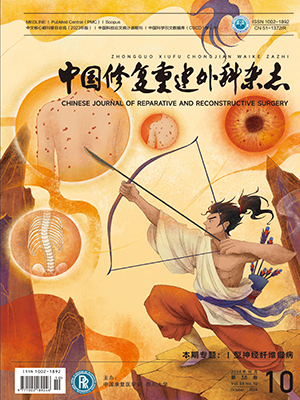Objective To investigate the in vivo degradable properties of new calcium phosphate cement (CPC) containing poly lactic-co-glycolic acid (PLGA) so as to lay a foundation for the future clinical application. Methods A novel CPC containing PLGA (CPC/PLGA) was prepared according to a ratio of 45% dicalcium phosphate anhydrous ∶ 45% partially crystallized calcium phosphates ∶ 10% PLGA. Thirty-two adult New Zealand rabbits (weighing 2.2-3.0 kg, male or female in half) were divided into the experimental group (n=17) and the control group (n=15). The bone defect models of the bilateral femoral condyles (4.5 mm in diameter and 1.5 cm in depth) were made by drilling hole. Defect at the right side was repaired with CPC/ PLGA in the experimental group and with CPC in the control group, while defect at the left side was not treated as blank control. The general condition of rabbits was observed after operation; the histological observation and bone histomorphometric analysis were performed at 2, 4, 8, 16, and 24 weeks; and scanning electronic microscope (SEM) observation was performed at 8 and 16 weeks after operation. Results All rabbits survived to the end of experiment. The histological observation showed: CPC/PLGA degraded gradually, and the new-born bone trabecula ingrew; bone trabeculae became rough and b; and CPC/PLGA almost biodegraded at 24 weeks in the experimental group. The CPC degradation was much slower in the control group than in the experimental group. The total bone tissue percentage was 44.9% ± 23.7% in the experimental group, and 25.7% ± 10.9% in the control group, showing significant difference between 2 groups (t=3.302, P=0.001); and the bone tissue percentage showed significant difference between 2 groups at 8, 16, and 24 weeks (P lt; 0.05). The results of SEM observation showed that the pore size was 100-300 μm at 8 weeks after operation, new-born bone trabecula grew into the pores and combined bly with residual cement in the experimental group. Conclusion Novel CPC/PLGA has good in vivo degradable properties, and it can be an ideal bone substitute in future clinical application.
Citation: LIAO Hongxing,DUAN Xin,ZHANG Ziji,ZOU Huazhang,YE Jiandong,LIAO Weiming. IN VIVO DEGRADABLE PROPERTIES OF A NOVEL INJECTABLE CALCIUM PHOSPHATE CEMENT CONTAINING POLY LACTIC-CO-GLYCOLIC ACID. Chinese Journal of Reparative and Reconstructive Surgery, 2012, 26(8): 934-938. doi: Copy




